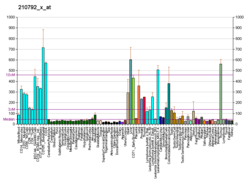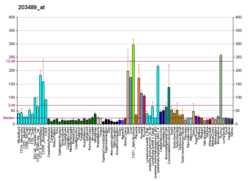SIVA1
Apoptosis regulatory protein Siva is a protein that in humans is encoded by the SIVA1 gene.[5][6]
This gene encodes a protein with an important role in the apoptotic (programmed cell death) pathway induced by the CD27 antigen, a member of the tumor necrosis factor receptor (TFNR) superfamily. The CD27 antigen cytoplasmic tail binds to the N-terminus of this protein. Two alternatively spliced transcript variants encoding distinct proteins have been described.[6]
Interactions
Siva (protein)
Siva protein is a zinc-containing intracellular ligand of the CD4 receptor that promotes HIV-1 envelope-induced apoptosis in T-lymphoid cells. Recent research has demonstrated that Siva is a direct transcriptional target for the tumor-suppressors p53 and E2F1. [7]
See also
References
- 1 2 3 GRCh38: Ensembl release 89: ENSG00000184990 - Ensembl, May 2017
- 1 2 3 GRCm38: Ensembl release 89: ENSMUSG00000064326 - Ensembl, May 2017
- ↑ "Human PubMed Reference:".
- ↑ "Mouse PubMed Reference:".
- 1 2 Prasad KV, Ao Z, Yoon Y, Wu MX, Rizk M, Jacquot S, Schlossman SF (Jul 1997). "CD27, a member of the tumor necrosis factor receptor family, induces apoptosis and binds to Siva, a proapoptotic protein". Proc Natl Acad Sci U S A. 94 (12): 6346–51. doi:10.1073/pnas.94.12.6346. PMC 21052. PMID 9177220.
- 1 2 "Entrez Gene: SIVA1 SIVA1, apoptosis-inducing factor".
- ↑ Fortin A, MacLaurin JG, Arbour N, et al. (July 2004). "The proapoptotic gene SIVA is a direct transcriptional target for the tumor suppressors p53 and E2F1". J. Biol. Chem. 279 (27): 28706–14. doi:10.1074/jbc.M400376200. PMID 15105421.
Further reading
- Maruyama K, Sugano S (1994). "Oligo-capping: a simple method to replace the cap structure of eukaryotic mRNAs with oligoribonucleotides". Gene. 138 (1–2): 171–4. doi:10.1016/0378-1119(94)90802-8. PMID 8125298.
- Suzuki Y, Yoshitomo-Nakagawa K, Maruyama K, et al. (1997). "Construction and characterization of a full length-enriched and a 5'-end-enriched cDNA library". Gene. 200 (1–2): 149–56. doi:10.1016/S0378-1119(97)00411-3. PMID 9373149.
- Henke A, Launhardt H, Klement K, et al. (2000). "Apoptosis in coxsackievirus B3-caused diseases: interaction between the capsid protein VP2 and the proapoptotic protein siva". J. Virol. 74 (9): 4284–90. doi:10.1128/JVI.74.9.4284-4290.2000. PMC 111945. PMID 10756043.
- Cao C, Ren X, Kharbanda S, et al. (2001). "The ARG tyrosine kinase interacts with Siva-1 in the apoptotic response to oxidative stress". J. Biol. Chem. 276 (15): 11465–8. doi:10.1074/jbc.C100050200. PMC 3476318. PMID 11278261.
- Henke A, Nestler M, Strunze S, et al. (2001). "The apoptotic capability of coxsackievirus B3 is influenced by the efficient interaction between the capsid protein VP2 and the proapoptotic host protein Siva". Virology. 289 (1): 15–22. doi:10.1006/viro.2001.1082. PMID 11601913.
- Held-Feindt J, Mentlein R (2002). "CD70/CD27 ligand, a member of the TNF family, is expressed in human brain tumors". Int. J. Cancer. 98 (3): 352–6. doi:10.1002/ijc.10207. PMID 11920585.
- Xue L, Chu F, Cheng Y, et al. (2002). "Siva-1 binds to and inhibits BCL-X(L)-mediated protection against UV radiation-induced apoptosis". Proc. Natl. Acad. Sci. U.S.A. 99 (10): 6925–30. doi:10.1073/pnas.102182299. PMC 124505. PMID 12011449.
- Strausberg RL, Feingold EA, Grouse LH, et al. (2003). "Generation and initial analysis of more than 15,000 full-length human and mouse cDNA sequences". Proc. Natl. Acad. Sci. U.S.A. 99 (26): 16899–903. doi:10.1073/pnas.242603899. PMC 139241. PMID 12477932.
- Spinicelli S, Nocentini G, Ronchetti S, et al. (2003). "GITR interacts with the pro-apoptotic protein Siva and induces apoptosis". Cell Death Differ. 9 (12): 1382–4. doi:10.1038/sj.cdd.4401140. PMID 12478477.
- Chu F, Borthakur A, Sun X, et al. (2004). "The Siva-1 putative amphipathic helical region (SAH) is sufficient to bind to BCL-XL and sensitize cells to UV radiation induced apoptosis". Apoptosis. 9 (1): 83–95. doi:10.1023/B:APPT.0000012125.01799.4c. PMID 14739602.
- Py B, Slomianny C, Auberger P, et al. (2004). "Siva-1 and an alternative splice form lacking the death domain, Siva-2, similarly induce apoptosis in T lymphocytes via a caspase-dependent mitochondrial pathway". J. Immunol. 172 (7): 4008–17. doi:10.4049/jimmunol.172.7.4008. PMID 15034012.
- Fortin A, MacLaurin JG, Arbour N, et al. (2004). "The proapoptotic gene SIVA is a direct transcriptional target for the tumor suppressors p53 and E2F1". J. Biol. Chem. 279 (27): 28706–14. doi:10.1074/jbc.M400376200. PMID 15105421.
- Gerhard DS, Wagner L, Feingold EA, et al. (2004). "The status, quality, and expansion of the NIH full-length cDNA project: the Mammalian Gene Collection (MGC)". Genome Res. 14 (10B): 2121–7. doi:10.1101/gr.2596504. PMC 528928. PMID 15489334.
- Chu F, Barkinge J, Hawkins S, et al. (2005). "Expression of Siva-1 protein or its putative amphipathic helical region enhances cisplatin-induced apoptosis in breast cancer cells: effect of elevated levels of BCL-2". Cancer Res. 65 (12): 5301–9. doi:10.1158/0008-5472.CAN-04-3270. PMID 15958577.
- Gudi R, Barkinge J, Hawkins S, et al. (2006). "Siva-1 negatively regulates NF-kappaB activity: effect on T-cell receptor-mediated activation-induced cell death (AICD)". Oncogene. 25 (24): 3458–62. doi:10.1038/sj.onc.1209381. PMID 16491128.
- Nestler M, Martin U, Hortschansky P, et al. (2006). "The zinc containing pro-apoptotic protein siva interacts with the peroxisomal membrane protein pmp22". Mol. Cell. Biochem. 287 (1–2): 147–55. doi:10.1007/s11010-005-9082-6. PMID 16683188.
- Severino A, Abbruzzese C, Manente L, et al. (2007). "Human papillomavirus-16 E7 interacts with Siva-1 and modulates apoptosis in HaCaT human immortalized keratinocytes". J. Cell. Physiol. 212 (1): 118–25. doi:10.1002/jcp.21011. PMID 17348035.
This article is issued from
Wikipedia.
The text is licensed under Creative Commons - Attribution - Sharealike.
Additional terms may apply for the media files.





